Octopus - a real tomato tree with a gigantic harvest
The Octopus tomato attracts special attention from summer residents. The hybrid was bred in Japan in the 1970-1980s and looks like a full-fledged tomato tree.
Tomato trees are in stable demand, because the harvest that can be harvested from them is much more abundant than from ordinary bush forms. At the beginning of this century, a tomato called Octopus was officially recognized by the Russian State Register. The Russian version of the hybrid was transferred to SeDek as the copyright holder. Our article contains characteristics and descriptions of this unusual crop, rules of cultivation and care.
Description and characteristics, yield indicators
Octopus tomatoes indeterminate, for this reason their side shoots are especially strongly developed. The octopus is not limited in growth.
The hybrid can be classified as late in terms of fruit ripening. From the appearance of tomato sprouts to harvest, 120-130 days pass.
The yield is 6-8 kg per bush at a time. The fruits on the bushes appear in racemose clusters, each with at least 5-6 tomatoes. The brushes are placed on the bush in the spaces between every three leaves.
The hybrid has good resistance to heat and is practically not susceptible to most known tomato diseases. The tomato is resistant to rot of any kind, tobacco mosaic and powdery mildew, and is immune to verticillium.
Each tomato is endowed with excellent taste, meaty, large and juicy. The weight of one fruit can reach 130 g.Tomatoes are round in shape, slightly flattened, and can be stored for a long time after picking.
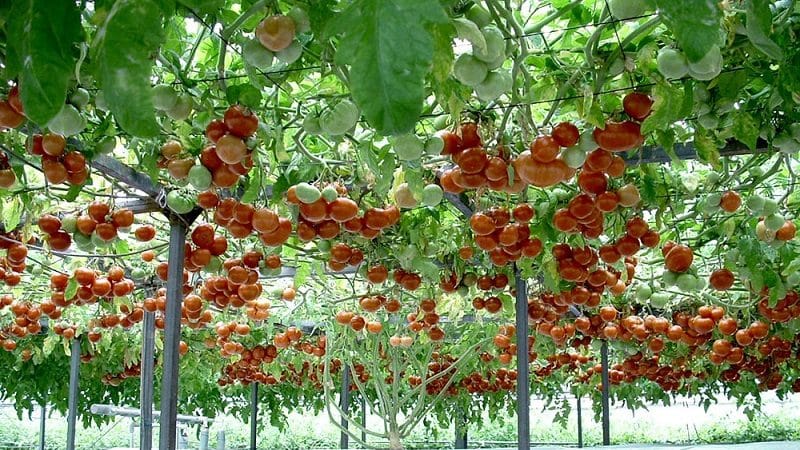
Related crops
In addition to the main type of hybrid tomato, Octopus, there are several modifications. The State Register includes the cherry Octopus F1 and the golden Octopus F1. There is also one unregistered, but quite successful and often used by gardeners species - Octopus cream F1.
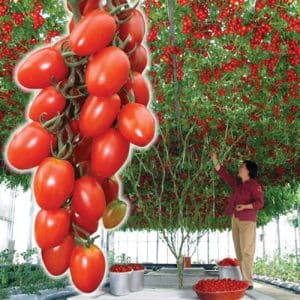
Cherry is one of the earliest ripening of all varieties of Octopus tomatoes; its ripening period is 100-105 days. In terms of yield, it gives the same good results as other varieties - up to 9 kg per 1 m². The tomato is tall; its growth can be limited using trellises. The fruits are round, dense, have a pleasant taste and bright red color, and can be stored for a long time.
Tomatoes Cherry Octopuses are small - 30-40 g. Their pleasant taste makes it possible to grow them for any purpose. Recently the Octopus Cherry Raspberry F1 was bred. It has the same characteristics as the classic Cherry.
Tomatoes Octopus cream F1 are distinguished by their cultivation only in closed ground. 2-3 stems should be left in the bush, the stepsons are cut off. The fruits are oval, weighing 30-40 g, can be of various colors, up to 10 tomatoes ripen on one bunch.
The golden octopus F1 immediately won the interest of gardeners, as the fruits have a bright orange color. The weight of one tomato is no more than 45 g; when grown in a greenhouse, the bush reaches 2 m in height, and the yield per 1 m² is 7-8 kg.
How to grow
There are 2 options for growing Sprut tomatoes - in open ground and greenhouse conditions. How productive a tomato will be depends on the growing method. Gardeners are often interested in how to grow tomatoes at home, rather than on a professional farm.
In greenhouses
The technology of growing in a greenhouse requires premises of a special configuration with special equipment. Octopus f1 is a tall tomato, so the ceiling of the greenhouse should be high. Additionally, it is necessary to organize a system along which the tomato will trail.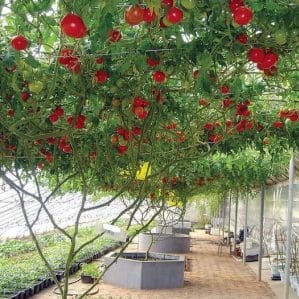
Seeds for planting must be purchased at a specialized store. Homemade raw materials are not suitable for planting. The advantage of purchased seeds is that they are already calibrated and processed by the manufacturer.
Planting begins in January-February; on cloudy days, the seedlings are provided with lighting. Before planting the seedlings in the soil of the greenhouse, they are grown to 30 cm. The bushes will grow, so when planting they are distributed at a distance from each other.
Once the plant is planted, it is provided with strong supports for weaving the crown. Plants are watered abundantly, mineral fertilizers are added, soil is added and the lower leaves are removed.
At first the bushes will stretch out like ordinary tall tomatoes, but by mid-August they will look like a tree. In some regions of the country, the Octopus tomato bears fruit until mid-October.
Attention! When grown in an ordinary greenhouse, the root can be dug up for the winter and planted again the next season.
In the open ground
Seedlings begin to be grown in January-February. For the first 7 days after planting a tomato tree in open ground, you will need to cover it with film, creating a greenhouse, the temperature in which should not be lower than 20-25 ° C.
For Sprut, loamy soil with humus inclusions is considered the ideal option. If there is no such soil, then it is created by adding humus compost.
The location of the bushes should be unshaded and well protected from the wind.The holes are dug to a depth of 20 cm, leaving gaps between the plants for growth. To ensure healthy and strong branches, the roots are pinched when planting.
Be sure to feed tomatoes with mineral fertilizers at least once every 3 weeks. There is no need to plant the plant. The most important thing in care is frequent and abundant watering. The roots are treated with iodine solution to avoid the development of diseases.
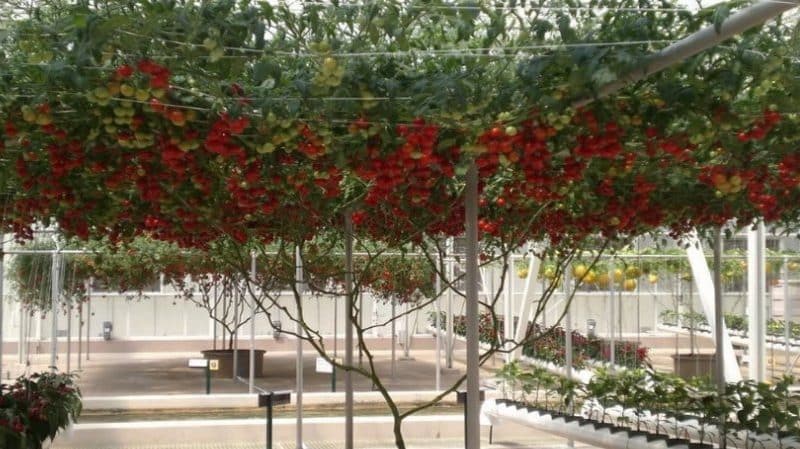
Features of hybrid fruiting
Octopus f1 will bear fruit only in a spacious place.
When grown in a greenhouse, a high ceiling and special fastenings or a place for weaving the crown are built. The greenhouse growing option involves keeping the bushes indoors in the winter. Heating will need to be installed in the greenhouse if it is not installed.
Plants are tied up as they grow. As soon as the first cluster of tomatoes ripens, all foliage is removed from it to allow the unhindered formation of the next cluster.
Prevention of diseases and pests
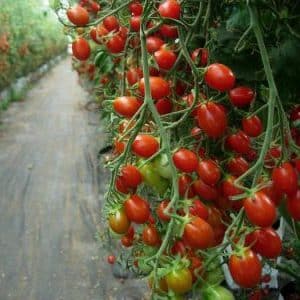
To combat pests the leaves are sprayed with a solution of cayenne pepper, laundry soap and water. Another option for scaring away unwanted guests is to plant dill next to tomato bushes. Insects cannot stand the smell of this spice.
Octopus is considered the most common tomato disease. late blight, from which the entire harvest could be lost. This disease is fought with both folk and traditional means.
Salt, kefir, garlic solutions or mixtures with ash work well. Chemicals that will help in such a situation are “Alyette”, “Antrakol”, “Quadris”.
Reviews from gardeners
Reviews from gardeners and gardeners about Octopus F1 tomatoes are positive. However, not many people take up the task of growing tomato trees.In most cases, planting takes place for one season in open ground or in an ordinary greenhouse, since growing Sprut tomatoes professionally is a difficult task.
Kirill, Yelets: “I collected at least 10 kg of tomatoes from one plant during the season. There is no need to pin it, it's convenient. But I spent a lot of time tying and strengthening the tomatoes so they wouldn’t fall.”
Elizaveta, Cheboksary: “During the season, the hybrid did not get sick, and aphids did not bother me, as usually happens with tomatoes. I was surprised by the rich harvest, with huge tassels, as in the photo.”
Conclusion
Farmers who professionally grow the Octopus tomato note its suitable properties for sale. The fruits inside and outside have increased density, which ensures transportation without damaging the tomatoes.
The unique taste in fresh and pickled form attracts a huge number of buyers. The tomato tree is an excellent option for growing in a small space or on a large farm.